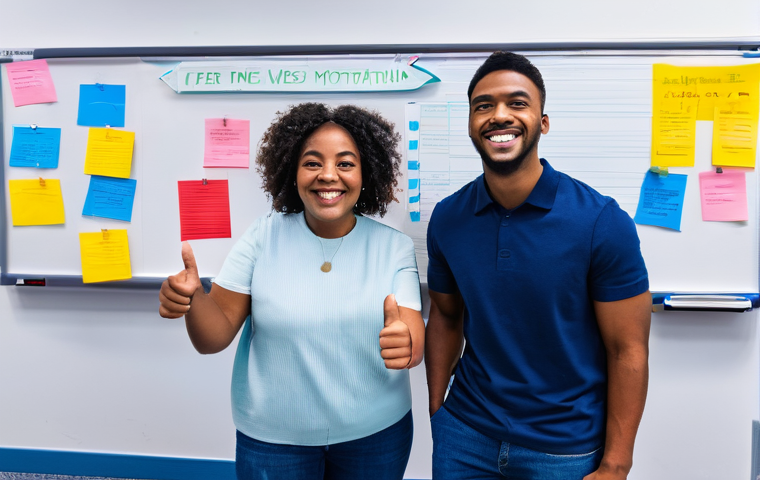Hey there, fellow coaches! Guiding self-directed learners is incredibly rewarding, but finding that sweet spot between empowering and over-directing can be a real challenge in our ever-evolving educational landscape.
I’ve personally witnessed how easily a well-intentioned suggestion can inadvertently undermine a learner’s crucial independence, especially when new AI tools and personalized learning paths are constantly emerging.
We’re not just delivering facts; we’re cultivating ownership and deep resilience, helping them navigate information overload and stay motivated on their unique journeys.
If you’ve ever wondered how to truly support independent minds without micromanaging, ensuring they build genuine self-reliance for the long haul, you’re in the right spot.
Let’s dive deep into the essential coaching rules every self-directed learning coach needs to master to truly make an impact.
Unleashing the Inner Compass: Helping Learners Find Their North Star

It’s fascinating, isn’t it? As coaches, we often feel the urge to hand over a meticulously crafted roadmap to our learners, especially when we see them grappling with a new concept or feeling a bit lost. But I’ve learned, sometimes the hard way, that true self-direction isn’t about following *our* map; it’s about helping them draw their own. Think about it: when you’ve navigated a new city purely by your wits and a few helpful signs, doesn’t that victory feel so much sweeter and more deeply ingrained than if you just followed a tour guide? That’s the feeling we’re aiming for. My own breakthrough came when I stopped trying to predict their every turn and instead focused on equipping them with better navigational tools. It means allowing for detours, celebrating unexpected discoveries, and really listening to *their* definition of success, not just projecting our own. This shift in perspective completely transformed how I approached my coaching sessions, leading to more engaged and genuinely independent learners who stuck with their goals much longer. They started owning their learning, and honestly, it felt incredible to witness that spark ignite within them.
Cultivating Curiosity, Not Just Answers
One of the biggest traps we can fall into is becoming the sole source of answers. When a learner hits a roadblock, our instinct is often to jump in with the solution. However, this subtly trains them to look outward for validation and solutions, rather than inward. Instead, I’ve found immense success by pivoting to questions that ignite their curiosity. “What do you think is the next logical step here?” or “If you had to guess, what resource might shed some light on this?” These aren’t just questions; they’re invitations to explore, to hypothesize, and to develop critical thinking muscles. I remember one learner who was stuck on a coding problem. Instead of showing them the fix, I asked, “What’s the smallest part of this that you *do* understand?” From that tiny anchor, they slowly unravelled the whole puzzle themselves. It took a bit longer, sure, but the pride and understanding they gained were invaluable.
Defining Success on Their Terms
We all have our ideas of what ‘successful learning’ looks like, but for a self-directed learner, their definition is paramount. Early in my coaching journey, I’d sometimes push for outcomes I thought were ideal, only to find learners disengaging. It was a wake-up call! Now, a crucial part of our initial conversations is diving deep into *their* vision. What does mastery feel like to them? What practical application are they hoping for? Are they aiming for deep theoretical understanding, or just enough to get a project done? Understanding their intrinsic motivations and desired end states helps me tailor my support, making it relevant and genuinely empowering. For example, one learner wanted to understand basic financial concepts not to become an analyst, but to better manage their small business. My coaching shifted from academic theories to practical budgeting tools, directly aligning with their personal success metrics.
Beyond the Blueprint: Cultivating True Learning Autonomy
There’s a subtle but significant difference between following a pre-set learning path and truly forging your own. Many coaches, myself included early on, would meticulously craft detailed learning blueprints for our learners. We thought we were being helpful, providing structure and clarity. But what I discovered, through numerous trial-and-error moments and watching my learners’ reactions, was that while a blueprint can be a starting point, it can also become a cage. True autonomy isn’t just about *choosing* a path; it’s about *designing* it, *adapting* it, and sometimes, *abandoning* it for a more suitable one. I realized my role wasn’t to be the architect, but more like a skilled landscape gardener – providing the right tools, suggesting fertile ground, and helping them prune when necessary, all while letting *their* vision for the garden flourish. It’s a dance, really, between offering guidance and fostering independence, and the magic happens when the learner takes the lead.
Empowering Decision-Making Muscles
It’s tempting to jump in and solve every little quandary a learner faces, but every time we do, we rob them of an opportunity to strengthen their decision-making muscles. I’ve started framing challenges not as problems to be fixed by me, but as opportunities for them to make informed choices. This often involves presenting a few viable options, discussing the pros and cons of each, and then stepping back to let them decide. For instance, if a learner is overwhelmed by too many online resources, instead of curating a list for them, I might ask, “Given your learning style, which of these resource types (videos, articles, interactive exercises) do you think would be most effective for you right now?” This shifts the ownership directly to them, and I’ve seen how this repeated practice builds confidence and self-awareness.
Encouraging Iteration and Adaptation
One of the most powerful lessons I’ve learned is that no learning plan is set in stone. The world changes, their interests evolve, and new resources emerge daily. Being rigid about a plan can actually hinder progress. I make it a point to regularly check in on the *effectiveness* of their chosen strategies, not just their progress on a task. “Is this method still serving you well?” or “What have you learned about *how* you learn best this past week?” These questions open the door for them to iterate, to adapt, and to continuously refine their approach. I recall a learner who was initially committed to daily flashcards for language learning, only to find it incredibly tedious. By encouraging them to reflect and adapt, they switched to immersive video content and their motivation soared. It’s about flexibility and learning to pivot when something isn’t working.
The Art of Asking: Guiding Without Giving All the Answers
Ah, the power of a well-placed question! This has become one of my absolute favorite tools in the coaching arsenal. It’s so easy to slip into the role of an oracle, dispensing wisdom and solutions, but I’ve found that approach, while seemingly helpful in the short term, is a real disservice to a self-directed learner. When I started coaching, I probably talked far too much. Over time, I’ve honed the skill of active listening and strategic questioning, realizing that the most profound ‘aha!’ moments rarely come from *my* pronouncements, but from the learner’s own insights sparked by a thought-provoking query. It’s like being a detective, not to solve the case yourself, but to guide the other person to find the clues and piece together the mystery. The satisfaction they get from figuring it out themselves is infinitely more valuable than any answer I could simply hand to them. It builds intrinsic motivation and genuine problem-solving skills, which are far more crucial in the long run.
Socratic Method in Practice
Embracing a Socratic approach has been a game-changer for me. Instead of immediately correcting a misconception or pointing out a missed step, I’ll pose questions that lead the learner to discover it themselves. For example, if a learner is struggling with a project deadline, instead of saying, “You need to break this down into smaller tasks,” I might ask, “What are the biggest components of this project, and how long do you estimate each might take?” or “Are there any dependencies that could slow you down?” These questions encourage them to analyze, anticipate, and strategize independently. I vividly remember coaching a young entrepreneur who was about to launch a product without proper market research. My initial impulse was to warn him, but instead, I asked, “Who is your ideal customer, and how do you know what they truly need?” He spent the next two weeks interviewing potential clients and came back with a much stronger, validated product idea.
Open-Ended Questions for Deeper Reflection
Closed questions (yes/no) have their place, but open-ended questions are where the magic truly happens for self-directed learning. They compel learners to articulate their thoughts, feelings, and reasoning, fostering deeper reflection and self-awareness. Questions like “What was the most challenging part of that task and why?” or “How did you feel when you finally accomplished X?” push them beyond surface-level responses. I often use prompts like “Tell me more about X” or “Walk me through your thought process when you encountered Y.” This isn’t just about getting information; it’s about helping *them* process their own learning journey. It helps them identify their strengths, pinpoint areas for improvement, and understand their unique learning patterns. This reflective practice is critical for turning experiences into genuine, lasting knowledge, far beyond just completing a task.
Building the Bridge: Fostering Resilient Learning Habits
Let’s be real, self-directed learning isn’t always sunshine and rainbows. There are moments of frustration, plateaus where progress seems to stall, and the ever-present temptation to just give up. As coaches, we’re not just guiding intellectual pursuits; we’re also helping to build the emotional and practical infrastructure that allows learning to continue even when things get tough. I’ve seen countless learners with brilliant minds falter because they hadn’t cultivated the habits to navigate these inevitable challenges. It’s not enough to be smart; you also need grit, organization, and a system that supports you. My personal journey through complex certifications taught me this firsthand: raw intelligence got me started, but consistent habits and resilience got me through to the finish line. So, a huge part of my coaching now focuses on helping learners construct this robust bridge of habits that will carry them over the rough patches.
The Power of Tiny Habits
When we talk about habits, it’s easy to get overwhelmed thinking about monumental shifts. But what I’ve found incredibly effective, and far less daunting for learners, is focusing on “tiny habits.” These are small, almost ridiculously easy actions that, when done consistently, build momentum. Instead of “study for an hour,” it might be “read one paragraph of the textbook after breakfast.” Or “review notes for five minutes before bed.” I encourage learners to identify one or two micro-habits related to their learning goals and commit to them daily. The victory of consistently completing a tiny habit builds confidence, and that confidence then fuels the desire for slightly larger habits. I worked with a learner who struggled with procrastination. We started with “open the relevant document for 2 minutes.” Within weeks, those 2 minutes turned into 10, then 20, because the barrier to entry was so low.
Establishing a Supportive Learning Environment
A learner’s environment – both physical and digital – plays a massive role in their ability to sustain self-direction. It’s often overlooked, but a chaotic desk or a distracting digital space can completely derail even the most motivated individual. I’ll often chat with my learners about how they’ve set up their workspace. Are there too many distractions? Is everything they need easily accessible? For digital environments, we might discuss strategies like using website blockers for focus, organizing digital files, or setting up dedicated ‘deep work’ sessions. One learner was constantly losing motivation because their study space was also their entertainment hub. We worked on creating a distinct ‘learning zone’ within their home, even if it was just a corner, and the psychological shift was immediate. It’s about making it as easy as possible to start and sustain focused work.
Navigating the Digital Ocean: Smart Tools and Mindsets for Modern Learners
Let’s face it, the sheer volume of information and digital tools available today can be both a blessing and a curse for self-directed learners. On one hand, knowledge is literally at their fingertips; on the other, it’s incredibly easy to get overwhelmed, distracted, or lost in a sea of irrelevant content. My own experience trying to keep up with the latest AI advancements taught me this lesson profoundly. I realized that merely pointing learners to “Google it” wasn’t enough; they needed a compass, a sextant, and a good anchor to navigate effectively. Our role as coaches now extends beyond subject matter to include digital literacy and discernment. We’re helping them develop a critical filter for information, efficiently leverage technology, and maintain focus in an increasingly noisy world. It’s about empowering them to be digital navigators, not just passive consumers.
Leveraging AI Wisely, Not Relying Blindly
The advent of AI tools has changed the learning landscape dramatically, and it’s something every self-directed learner needs to understand. My coaching now includes discussions on how to use tools like ChatGPT, Gemini, or even advanced search engines, not as a shortcut to avoid learning, but as a powerful assistant. We talk about using AI for brainstorming ideas, summarizing complex texts, generating practice questions, or even getting quick explanations for difficult concepts. However, I emphasize the critical importance of verification, understanding the limitations, and always, always doing the final intellectual heavy lifting themselves. I guide them to use AI as a collaborator, much like a research assistant, rather than a replacement for their own thinking. It’s a delicate balance, but mastering it is essential for modern learning.
Developing Information Filtering and Curation Skills

With an endless stream of articles, videos, and opinions, the ability to filter and curate information is a superpower. I actively work with learners on developing this skill. This involves teaching them how to evaluate sources for credibility (who created this? what are their biases?), how to identify key takeaways from dense material, and how to effectively organize what they learn. We often discuss strategies like using RSS feeds, curated newsletters, or even simple note-taking apps to capture and synthesize information without getting overwhelmed. I remember a learner who was drowning in medical research for a personal project. By coaching them on identifying reputable journals and using specific search operators, they transformed their chaotic research into a focused and productive process, saving them hours and reducing their stress levels dramatically.
Celebrating the Small Wins: Fueling Long-Term Motivation
You know that feeling when you’ve been slogging through a tough project, and you finally hit a minor milestone? The little burst of energy, the sense of accomplishment, that push to keep going? That’s the magic of celebrating small wins, and it’s absolutely crucial for sustaining long-term motivation in self-directed learning. It’s so easy for learners, and even for us coaches, to get fixated on the giant, distant goal. But when that goal feels impossibly far away, motivation can dwindle faster than a candle in a strong breeze. I’ve seen it happen countless times – enthusiasm starts high, then slowly fades into the background noise of daily life. My own experience with learning a new language taught me this vividly; if I hadn’t celebrated mastering a new phrase or understanding a short conversation, I would have given up long before achieving fluency. Our role is to help learners recognize, acknowledge, and revel in those smaller victories, effectively creating a continuous feedback loop of positive reinforcement.
Acknowledging Incremental Progress
The journey of self-directed learning is rarely a straight line; it’s a series of small, often irregular, steps forward. As coaches, we need to help learners see and appreciate these incremental gains. This means actively pointing out progress that they might overlook. “Remember when you couldn’t even grasp this concept last month? Look at you now!” or “That’s a significant improvement in your writing style from where we started.” I encourage learners to keep a ‘win journal’ or a simple progress tracker where they can physically see how far they’ve come. It’s a powerful visual reminder on days when they feel stuck. One learner, initially despondent about their slow progress in coding, started logging every successful line of code they wrote. Seeing that list grow transformed their perspective and reignited their passion for the subject.
Building in Regular Reflection and Reward
Beyond just acknowledging progress, actively building in moments for reflection and small, self-chosen rewards can significantly boost motivation. At the end of a week, for instance, I might ask, “What was your biggest learning breakthrough this week, and how will you acknowledge that?” The ‘reward’ doesn’t have to be grand; it could be enjoying a favorite treat, taking a short break to do something they love, or simply allowing themselves a moment of genuine self-congratulation. The key is for the learner to consciously connect the effort with a positive feeling. This creates a positive reinforcement loop.
| Motivation Boosters | Potential Pitfalls to Avoid |
|---|---|
| Setting clear, achievable mini-goals | Only focusing on the final, distant goal |
| Regularly reviewing and celebrating small successes | Ignoring progress, only noticing setbacks |
| Connecting effort to positive emotional experiences | Viewing learning as a chore or obligation |
| Sharing achievements with a supportive community/coach | Isolating oneself in the learning process |
| Incorporating varied learning methods to prevent boredom | Sticking to one method even if it’s ineffective or dull |
When to Step Back: Trusting the Learner’s Journey
This might be the hardest lesson I’ve had to learn as a coach: knowing when to simply step back and trust the process. It’s counter-intuitive, isn’t it? Our instinct is to always be present, to guide, to offer wisdom. But true self-directed learning absolutely requires space for the learner to grapple, to stumble, and crucially, to figure things out on their own. I remember a pivotal moment early in my career when I was coaching a particularly bright individual. They were stuck, and I had a clear solution in my mind. Every fiber of my being wanted to just *tell* them. But I held back, offered a simple encouraging word, and gave them the space. The next session, they came back beaming, having not only solved the problem but discovered a more elegant solution than I had even considered. That’s when it truly clicked: sometimes, the most powerful coaching move is quiet confidence, allowing the learner to own their struggle and their ultimate triumph. It’s about believing in their capacity for resilience and discovery.
Resisting the Urge to Rescue
It’s a common coaching pitfall: the ‘rescue’ impulse. When a learner is struggling, especially if they’re showing signs of frustration or confusion, our natural empathy kicks in, and we want to swoop in and make it better. However, constantly rescuing a learner prevents them from developing their own problem-solving capabilities and resilience. I’ve trained myself to pause and ask, “Is this a moment where my direct intervention is truly necessary, or is this an opportunity for them to build grit?” Often, it’s the latter. Instead of providing the answer, I might offer a gentle nudge, a clarifying question, or simply a word of encouragement: “You’re capable of figuring this out,” or “What’s one small step you could try?” This subtle shift empowers them to push through discomfort and emerge stronger on the other side.
Fostering Independence Over Dependence
The ultimate goal of coaching self-directed learners is to render ourselves, in some ways, obsolete. We want to equip them with the tools and mindset to continue their learning journey long after our coaching relationship ends. This means actively fostering independence and guarding against any form of dependence. I make it clear from the outset that my role is to support *their* journey, not to carry them. This translates into encouraging them to find their own resources, set their own schedules, and critically evaluate their own progress. If a learner constantly comes to me with questions they could easily answer themselves, I’ll gently guide them back to their own problem-solving process. For example, “Where would you typically look for that kind of information?” or “What steps have you already taken to try and find an answer?” It’s a commitment to their long-term growth, even if it means short-term discomfort.
Connecting the Dots: The Power of Reflective Practice
You know how sometimes you learn something new, and it feels important, but then a week later, it’s just kind of… gone? That’s often because we haven’t given our brains the chance to truly process, integrate, and connect that new information with what we already know. For self-directed learners, who are constantly consuming new ideas and tackling new challenges, reflective practice isn’t just a nice-to-have; it’s absolutely non-negotiable. It’s the secret sauce that turns raw information into deep, meaningful understanding and lasting knowledge. I’ve personally found that the most significant leaps in my own learning come not just from doing, but from taking the time to pause, think, and articulate what I’ve learned. It’s during these reflective moments that the scattered pieces of information click into a cohesive, actionable framework. Our role as coaches is to actively guide learners through this crucial process, helping them build their own internal knowledge architecture.
Structured Debriefs and Journaling
Random reflection is good, but structured reflection is powerful. I incorporate regular debriefs into our coaching sessions, not just to review tasks, but to explore the *learning* that occurred. Questions like, “What surprised you the most about that process?” or “How might this new knowledge change your approach to X in the future?” prompt deeper thought. Beyond our sessions, I often recommend journaling as a personal reflective tool. This isn’t about writing a diary, but about metacognitive journaling – recording what they learned, how they learned it, what challenges they faced, and what strategies helped them overcome those challenges. I’ve seen learners who started journaling transform their understanding of their own learning process, identifying their most effective strategies and areas needing improvement with incredible clarity. It’s like having a personal learning analyst in their own mind.
Synthesizing and Articulating New Knowledge
The true test of understanding isn’t just being able to recall information; it’s being able to synthesize it, explain it in your own words, and connect it to broader concepts. I encourage learners to actively articulate what they’ve learned, whether it’s by teaching a concept to someone else (even a rubber duck!), writing a summary, or creating a mind map. This act of externalizing their understanding forces them to organize their thoughts, identify gaps in their knowledge, and solidify their grasp of the subject. I had one learner who was struggling with a complex marketing theory. I challenged her to explain it to me as if I were a complete beginner. The process of simplifying and clarifying the concepts for me ultimately led to her own profound understanding, far beyond what rote memorization could have achieved. It’s a powerful way to ensure that learning isn’t just temporary, but deeply integrated.
Bringing It All Together
Phew! What a journey we’ve taken through the incredible world of self-directed learning. If there’s one thing I hope you take away, it’s that our role as guides isn’t to draw the map for others, but to help them discover their own inner compass.
Watching a learner truly own their progress, celebrate their unique victories, and navigate their own challenges is, in my book, one of the most rewarding experiences imaginable.
It’s about building a foundation of resilience, curiosity, and genuine autonomy that serves them far beyond any single subject. Keep empowering, keep questioning, and most importantly, keep trusting in the amazing capacity of every individual to find their North Star.
Unlock Your Learning Potential: Pro Tips & Resources
1. Embrace the Power of Micro-Habits: Don’t underestimate the compounding effect of tiny, consistent actions. Instead of aiming for monumental shifts, identify one or two ridiculously small habits related to your learning goal – perhaps reading one paragraph of a challenging text each morning, or spending five minutes organizing your digital notes.
The joy of consistently achieving these small victories builds momentum and confidence, making larger goals feel far more attainable and less overwhelming in the long run.
It’s truly a game-changer for overcoming procrastination and fostering lasting discipline. 2. Cultivate a Curious Mindset with Strategic Questioning: Move beyond just seeking answers and start asking “why” and “how.” When faced with a problem, instead of immediately looking for the solution, challenge yourself or your learners with open-ended questions like, “What’s the smallest part of this that you *do* understand?” or “If you had to hypothesize, what might be going on here?” This approach isn’t about finding the ‘right’ answer immediately, but about fostering critical thinking, exploration, and the invaluable skill of independent problem-solving.
It transforms roadblocks into opportunities for deeper understanding. 3. Optimize Your Learning Environment – Both Physical and Digital: Your surroundings have a profound impact on your focus and motivation.
Take a moment to assess your physical workspace: Is it free from distractions? Is everything you need readily accessible? Similarly, consider your digital environment.
Are your files organized? Do you have tools to minimize online distractions? Creating a dedicated “learning zone” (even if it’s just a specific corner of a room) and implementing digital hygiene practices can drastically improve your ability to concentrate and stay engaged with your self-directed studies.
4. Leverage AI as a Smart Collaborator, Not a Crutch: The current generation of AI tools is incredibly powerful, but their true value lies in how you use them.
Think of AI as your highly intelligent research assistant, not your personal brain replacement. Use it for brainstorming, summarizing complex articles, generating practice questions, or getting quick explanations.
However, always verify information, understand the limitations, and ensure you’re still doing the heavy intellectual lifting yourself. Mastering this balance is key to staying competitive and innovative in today’s rapidly evolving information landscape.
5. Prioritize Regular Reflection and Deliberate Practice: Learning isn’t truly complete until you’ve reflected on it. Make it a habit to regularly pause and ask yourself: “What did I learn today/this week?” “What challenged me, and how did I overcome it?” “How does this new knowledge connect to what I already know?” Structured debriefs, journaling, or even explaining a concept to a friend (or a rubber duck!) can help solidify understanding, identify knowledge gaps, and turn transient information into deeply integrated, lasting knowledge.
This metacognitive practice is the secret sauce for sustained growth and mastery.
Your Learning Journey: Essential Reminders
* Empowerment Over Dictation: Your role, whether for yourself or others, is to guide the journey of discovery, not to prescribe every step. * Small Wins Fuel Big Progress: Consistently acknowledge and celebrate incremental achievements to build momentum and maintain motivation.
* Questions Spark Curiosity: Use open-ended questions to foster critical thinking and independent problem-solving, rather than always providing direct answers.
* Environment Matters: A supportive physical and digital learning space significantly enhances focus and long-term engagement. * AI is a Tool, Not a Replacement: Utilize technology wisely to enhance your learning, but always prioritize your own intellectual engagement and critical assessment.
* Reflect for Retention: Make time to process and synthesize new information; this is where true, lasting understanding takes root.
Frequently Asked Questions (FAQ) 📖
Q: How can I truly empower self-directed learners without accidentally falling into the micromanagement trap?
A: Oh, this is such a common dilemma, and one I’ve wrestled with myself many times! The key is to shift your mindset from “telling” to “guiding.” From what I’ve seen, truly empowering learners means giving them ownership, but not just throwing them into the deep end.
Start by setting clear expectations and desired outcomes, but let them choose how they get there. Think of yourself less as a supervisor and more like a seasoned explorer providing a map and compass, rather than dictating every step of the journey.
I’ve found that regularly checking in with open-ended questions like, “What’s your biggest challenge right now?” or “What resources have you discovered that are working well for you?” works wonders.
It encourages them to reflect and problem-solve independently, while still knowing you’re there for support. Remember, adults crave ownership and relevance in their learning, so connecting their chosen path to their personal and professional goals is incredibly motivating.
It’s about building their confidence to navigate their own learning landscape.
Q: With so many new
A: I tools emerging, how can I help my self-directed learners integrate them effectively without becoming overly reliant or losing their critical thinking skills?
A2: This is a fantastic and incredibly relevant question, especially right now! It’s true, AI can be a game-changer, but like any powerful tool, it needs to be used wisely.
My approach has been to encourage learners to view AI as a co-pilot or research assistant, not the main pilot. I often suggest they use AI for tasks like brainstorming ideas, summarizing large amounts of information, or getting different perspectives on a topic, but then critically evaluate the AI’s output themselves.
For instance, I’ve had learners use an AI to generate a first draft of an essay summary, then challenge them to refine it, check for accuracy, and add their unique insights.
It’s about teaching them how to prompt effectively and how to question the results. I also emphasize using AI to enhance their learning process, like identifying skill gaps or suggesting personalized learning paths, rather than simply getting answers.
The goal is to leverage AI to free up their mental energy for higher-order thinking and problem-solving, not to replace it.
Q: How do I keep self-directed learners motivated and resilient, especially when they hit roadblocks or feel overwhelmed by the sheer volume of information out there?
A: This is where the “coach” in “self-directed learning coach” really shines! I’ve personally seen learners get discouraged when they hit a wall, and that’s completely normal.
What truly helps them bounce back is fostering a strong sense of purpose and celebrating small wins. When someone is feeling overwhelmed, I encourage them to break down their big goals into tiny, manageable steps.
We’re talking micro-goals that are almost impossible to fail! This builds momentum and a sense of accomplishment. I also advocate for reflecting on failures not as setbacks, but as valuable learning opportunities – “What did this teach you?” or “How can you adapt next time?” is a powerful reframe.
Additionally, reminding them of their “why” – why they started this journey in the first place – can reignite that intrinsic motivation. Sometimes, just having a supportive space to voice their frustrations and strategize solutions with a trusted coach makes all the difference.
Building resilience is a journey, not a destination, and my role is to help them appreciate every step of that process.
📚 References
Wikipedia Encyclopedia
구글 검색 결과
구글 검색 결과
구글 검색 결과
구글 검색 결과
구글 검색 결과






